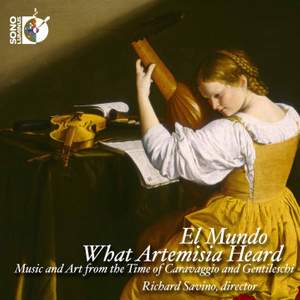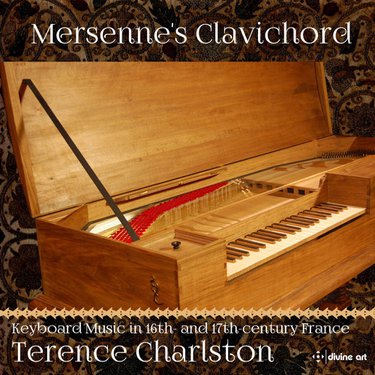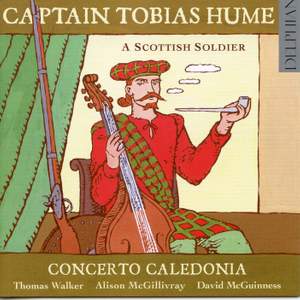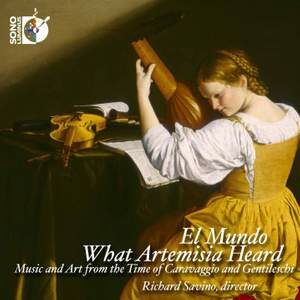Program: #22-32 Air Date: Aug 08, 2022
To listen to this show, you must first LOG IN. If you have already logged in, but you are still seeing this message, please SUBSCRIBE or UPGRADE your subscriber level today.
Music from the time of Caravaggio, the 17th century French clavichord repertoire, and Concerto Caledonia plays Tobias Hume.
I. What Artemisia Heard: Music and Art from the Time of Caravaggio and Gentileschi. (El Mundo/Richard Savino). Dorian Sono Luminus CD DSL-92195.

What Artemisia Heard: Music and Art from the Time of Caravaggio and Gentileschi is the profoundly engaging culmination of a unique project envisioned by El Mundo artistic director Richard Savino. Enraptured over the work of female Baroque painter Artemisia Gentileschi, Savino, a baroque guitarist and lutenist, began to question why the music of Artemisia’s time is not as widely appreciated as the visual arts of the era. Recognizing a ubiquitous connection in popular music between the aural and visual (through vehicles such as music videos), Savino had the ingenious idea to integrate the sublime painting of Artemisia and her contemporaries directly with the equally sublime music these painters would have heard at the time. Featured alongside paintings by Artemisia and her contemporaries is music by composers Uccellini, Kapsberger, Ferrari, Frescobaldi, Mazzocchi, Gagliano, Caccini, Piccinini, Castello, Monteverdi, Corbetta, Falconieri, Rossi, Giramo, and Lanier, as performed stunningly by El Mundo and distinguished soloists.
Prologo
- La Gran Battaglia - Marco Uccellini 3:37
Prima Roma: 1593 - 1614
- L’onda che limpida “Suite” - Giovanni Girolamo Kapsberger 5:44
- Corrente Sesta - Giovanni Girolamo Kapsberger 1:12
- Capona - Giovanni Girolamo Kapsberger 2:29
- Amanti - Benedetto Ferrari 4:20
- Canzona - Girolamo Frescobaldi 2:40
- Folle Cor - Domenico Mazzocchi 3:28
Seconda Parte: Firenze 1614 - 1620
- Sinfonia - Marco Gagliano 2:21
- Lasciatemi qui solo - Francesca Caccini 5:26
- Toccata - Alessandro Piccinini 1:35
- Chi desia di saper - Francesca Caccini 1:59<
Terza Parte: Venezia 1620 - 1630
- Sonata Prima - Dario Castello 4:32
- Et è pur dunque vero - Claudio Monteverdi 7:22
- Come dolce hoggi l’auretta- Claudio Monteverdi 3:20
- Sinfonia a due - Francesco Corbetta 3:40
Quarto Parte: Napoli 1630 - 1638
- Sinfonia detta la buon’hora - Andrea Falconieri 2:14
- Occhi belli - Luigi Rossi 3:01
- Folia echa para mi Señora Doña Tarolilla di Carallenos - Andrea Falconieri 4:34
- Festa Riso - Pietro Giramo 1:49
Quinto Parte: Londra 1638 - 1642
- Symphonia in G - Nicholas Lanier 1:32
- No More Shall Meads be Deck’d with Flow’rs- Nicholas Lanier 3:35
- Thou I Am Young - Nicholas Lanier 1:58
Epilogo
- Fan battaglia - Luigi Rossi 3:17
II. Mersenne’s Clavichord: Keyboard Music in 16th and 17th century France (Terence Charlston, clavichord). Divine Art CD dda 25134.

This recording is part of a broader project to explore sixteenth- and seventeenth-century French keyboard music through the touch and sound of the clavichord. Modern players and makers have tended to attach little importance to the rôle of the clavichord in the development of French keyboard music. This is for two main reasons. Firstly, we lack original instruments to play and copy since no clavichords of incontrovertible French origin survive. Secondly, the era of the clavichord’s greatest popularity in France, the sixteenth century, overlaps with a lacuna of nearly 150 years from which practically no printed or manuscript keyboard music remains. Nonetheless the clavichord was highly valued within late-renaissance culture and continued to be used by musicians into the seventeenth century and later. At least forty-one professional musicians between 1557 and 1793 possessed one or more clavichords (including Armand L. Couperin in the year of revolution, 1789) and some famous harpsichord makers (for example, Henri Hemsch) had clavichords in their workshops. Like the lute, the clavichord’s intimate and expressive voice must have enjoyed a favoured status in aristocratic and learned circles.
The clavichord was known in France from at least the fifteenth century. It is described and illustrated in the treatise of Henri Arnaut de Zwolle (astronomer and physician to Philip the Good, Duke of Burgundy, and later in Paris to Charles VII and Louis XI), which dates from the 1440s. Literary sources also attest to the fashion for the clavichord at court. The word for clavichord, manicordion, entered popular speech, for example, as in the expression ‘Elle a joué du manicordion’ which implied that a young girl had a lover. The clavichord’s popularity was at its height in France in the sixteenth century. Nicolas Bontemps was building clavichords in Lyons between 1506 and 1516 and the publishers Attaingnant and Gardane cite the clavichord amongst the instruments suitable for the performance of their keyboard prints. The clavichord is shown accompanying the recorder in a Gobelin tapestry and Jacques Cellier, organist of Rheims Cathedral, noted the identical case structure of the épinette (a rectangular virginals, here translated as ‘spinet’) and the clavichord (c. 1587). Clavichords were present in the workshops of Yves Mesnager (1556) and Claude and Robert Denis (1587 and 1589), and in musicians houses, for example, Nicolas Robillard (1557). The Parisian organist, Guillaume Raguenet, is recorded in the Minutier central of 1557 as contracted to give lessons on the spinet and clavichord. The court musicians, particularly the specialist joueurs d'épinette such as Pierre and Jean Dugué, and Thomas Champion, must surely have played both clavichord and spinet.
In the early seventeenth century, clavichords are mentioned in many official inventories. These include evidence of clavichord related trade with Spain (1606 and 1628), and clavichords within the estates of the instrument makers, Jean Jacquet (1632), Jean Denis (1672) and Pierre Baillon (1682), and eight musicians including Pierre Chabanceau (1600), Nicolas Gigault (1662) and Henri Dumont (1684). Pierre Trichet, in his Traité des instruments de Musique (c. 1640) notes its usefulness to train the hand in ‘suppleness on the harpsichord, spinet or the organ’ (1640). Trichet also states his preference for the word clavichordium to designate ‘clavichord’ rather than manichordion which can be mistaken for another instrument, the monochord. Clavichordium can mean any keyboard instrument or more specifically a harpsichord, however, so rather than clarifying the matter, Trichet serves to underline the inherent problems of musical instrument terminology in historical documents. The lack of a single surviving French clavichord makes the detailed description and plans in Marin Mersenne’s Harmonie Universelle, published in Paris 1636 or 1637 all the more significant and tantalising.
Marin Mersenne (1588–1648), theologian, philosopher and mathematician, was fascinated by music and sound. He corresponded widely to assemble the material for his monumental musical encyclopedia, Harmonie Universelle, and took great pains to get it printed. In the fourth part, the Traité des Instrumens, he includes, amongst descriptions of other more familiar stringed keyboard instruments including the virginal (épinette), and the harpsichord, a detailed account and illustration of the clavichord. Although no clavichord sharing Mersenne’s unusual design has survived, there is no reason to doubt that such instruments existed or that Mersenne had first-hand experience of them. Mersenne’s illustration has been shown to be isometric and the exact proportions he gives have enabled the British clavichord maker, Peter Bavington, to build a working example. Playing this meticulous and very musical reconstruction inspired my search to understand how such an instrument might have been used and what music might have been played upon it. It has a distinctive and attractive sound, similar in many ways to the lute or guitar, and is an elegant vehicle for all styles of keyboard music current at the turn of the sixteenth century and later.
Finding appropriate repertoire for the Mersenne clavichord is not quite as simple as it might seem. Very little French keyboard music survives from the period after the seven printed keyboard books published by Pierre Attaingnant (c. 1494–1551/2) in 1531 and before the relative wealth of surviving late seventeenth-century manuscript and printed volumes. Exceptions to this dearth of printed material include the two volumes of organ music by Jehan Titelouze (1623 and 1624), Fugues et caprices by François Roberday (1660), and a few keyboard versions of ensemble pieces by Henry Du Mont (1652 and 1657). All seven of Attaingnant's seven keyboard publications include the clavichord in their titles, ‘en la tablature du ieu Orgues, Espinettes et Manichordions’ for example, but no later sixteenth-century publication specifies clavichord performance. Keyboard players of the time did not limit themselves, however, to playing just one type of keyboard instrument but rather realised their musical ideas, often improvised, on any one of the many different types available to them. These included the harpsichord family (plucked strings), organs (both in church and in secular spaces) and the clavichord.
Generic keyboard music (i.e. specific to a certain instrumental tradition, e.g. organ or harpsichord) can also be performed on instruments other than the one seemingly intended. Throwing their net ever wider, keyboard players were arranging non-keyboard music. Vocal intabulations (motets, chansons), instrumental counterpoint and dances, and lute music in general, were fair game for any keyboard instrument, not least the clavichord.
A vast range and number of pieces (running to many hours of music) were considered for inclusion in this recording, and these have been reduced to a handful of representative items. The recording is divided into three main historical periods, the sixteenth century, the early seventeenth century and the later seventeenth century. This chronological progression is interleaved with different genres and styles. Lute music translates well to the clear speech, refined sonority and subtle dynamic nuance of the clavichord. As David Ledbetter has comprehensively shown, the sound and technique of the lute style was fundamental to the evolution of the mature French harpsichord style. One very important outcome of this project and recording is the demonstration of how well the earlier keyboard music sounds performed on the clavichord, suggesting an earlier evolution of the clavecinistes touch and repertoire in which the clavichord played a significant part located somewhere between lute and spinet.
The design of the Mersenne clavichord has a direct impact on its touch and sound. Its full, chromatic compass suits the majority of the repertoire and its light key action, with long keys and tangents, is not dissimilar to a lightly voiced Franco/Flemish harpsichord. The sound is greatly affected by the five bridges, each of which has a distinctive sound with the difference between bridges most pronounced where one ends and another begins. Thus the instrument can be said to have (at least) four registers or characters, approximately corresponding to the vocal ranges, treble, alto, tenor and bass. These characteristics are distinctive from other contemporary clavichords and set considerable technical and interpretational challenges for the player to overcome.
The 16th Century
|
Sancta Trinitas |
Antoine de Févin (b ?Arras, c1470; d Blois, late 1511 or early 1512). |
Treize motets et un prelude pour orgue : parus en 1531... |
|
Prelude sur chacun ton |
[Attaingnant, pub.] |
[Livre II] 6. Magnificat sur les huit tons … 1531 |
|
Longtemps y a que je vis en espoire |
Anon. |
Vingt et cinq chansons musicales reduictes … 1530(sic) |
|
La Magdalena |
P.D. [Pierre Blondeau? (fl Paris, 1st half of the 16th century)] |
Dix huit basses dances … en tablature du Lutz, 1529, p. i. |
|
Sy pour aymer |
Pierre [Regnault] Sandrin (b ?St Marcel, nr Paris, ?c1490; d ?Italy, after 1560). |
Munich Mus. Ms. 2987 |
|
Prelude |
[Attaingnant, pub.] |
Treize motets et un prelude pour orgue : 1531... |
|
Fantasie |
Guillaume Costeley (b Fontanges-en-Auvergne, c1530; d Evreux, 28 Jan 1606) |
F-Pn fr.9152, f. 189. Source: h |
|
Hors envyeux |
Nicolas Gombert (b c1495; d c1560). |
Munich Mus. Ms. 2987 |
|
La brunette & La shy myze |
Anon. |
GB-Lbl Add. MS 30513 (Mulliner Book), ff. 16v & and 17. |
|
Moneghina Gagliarda & Gamba Gagliarda |
Antoine Gardane [Gardano] (b southern France, 1509; d Venice, 28 Oct 1569). |
|
|
Prelude' [Tablature?] |
Pierre Megnier [G] |
F-Pn fr.9152, f. 165. Source |
|
Pavane |
Jacques Cellier (b France, mid-16th century; d Reims, c1620). |
F-RS, MS 971, ff. 34, 34v |
The early-17th Century
|
5 pieces: Canaries - Pavane de Aranda - Borree - Volte appellee la Marcielleze - Fantasie sur l'air de ma Bergerer |
GB-A π 7841 Arc |
|
|
Fantasie |
Charles Racquet (b Paris, 1597; d Paris, 1 Jan 1664). |
Mersenne, 1636. MS insert. |
|
‘Tu crois, ô Beau Soleil’ |
Pierre [iii] de la Barre (b Paris, bap. 27 Jan 1592; d Paris, bur. 31 March 1656). |
Mersenne, 1636. RAM 1637 copy. |
|
2 pieces: Prelude - Volta |
Mercure d'Orléans (fl c1590–c1619) |
D-Hs, Ms. 3238 (now M B/2768), p.4 and G.L. Fuhrmann, Testudo Gallo-Germanica, Nuremburg, 1615, p.177. |
|
4 Preludes |
Anon. |
GB-Lbl Add. MS 29486 |
|
Toccata 19a |
Jan Pieterszoon Sweelinck (b Deventer, ?May 1562; d Amsterdam, 16 Oct 1621). |
B-Lu 153, olim 888 (Liege ms) |
|
Echo |
Gérard Scronx (fl Liège, early 17th century). |
B-Lu 153, olim 888 (Liege ms) |
|
5 pieces: Bergamasca - Gavotte - Courante 'La Chabotte' - 'Hereux séjour de Partenisse' (Boësset) - Bransle 'Les Frondeurs' (Pinel) |
F-Psg 2350/57 |
The later-17th Century
|
Noel: Laissez paistre vos Bestes |
Nicolas Lebègue (b Laon, c1631; d Paris, 6 July 1702). |
Second livre d’orgue (Paris, ?1678) |
|
Duo |
Mr. Couperin |
F-Pn Rés.Vm7 674–5 (Bauyn II), 59v-60v. |
|
Recit a 3 |
Nicolas Gigault (b ?Paris, c1627; d Paris, 20 Aug 1707). |
Livre de musique pour l’orgue … (Paris, 1685) |
|
Sarabande |
Jacques Champion, Sieur de Chambonnières (b Paris, 1601/2; d Paris, 1672, before 4 May). |
Oldham, no. 16 [ff. 16v-17r] |
|
Prelude |
Jean Henry D’Anglebert (bap. Bar-le-Duc, 1 April 1629; d Paris, 23 April 1691). |
F-Pn Rés. 89ter, ff. 52v-55r. |
III. Captain Tobias Hume: A Scottish Soldier (Concerto Caledonia/David McGuiness). Delphian CD DCD34140.

From MusicWeb International: Some composers attract attention for other than strictly musical reasons. One of them is Gesualdo, for murdering his wife and her lover. Another is Stradella, who paid for his womanizing by being stabbed to death. Tobias Hume is also someone who fascinates, especially because he led an adventurous life as a professional soldier. His comments about his exploits further excite the imagination: we meet a person who is not exactly modest about his qualities as a soldier or about his musical skills. The fact that so little is known about his life leaves the field clear for the imagination. It is impossible to write his biography: we don't know when he was born and there is even a gap in the information about his whereabouts between 1607 and 1629.
In the former year he published a second book comprising vocal and instrumental pieces. It was preceded in 1605 by his first collection of basically the same content, although less organised. These were not so much a token of his social standing but rather of his precarious position. The second book was dedicated to Queen Anne, and he described it as "the last hope of my labours". It is also telling that his name is hardly ever mentioned by other musicians and composers of his time. A remark from the pen of John Dowland is rather negative, as he defended the lute against Hume's championing of the viol.
The two collections were first and foremost intended for the viola da gamba, the instrument Hume himself played. However, Hume suggested alternative scorings, with ensembles of various instruments, including wind. It is this suggestion which has been picked up by the Concerto Caledonia, which plays using gambas, flutes, virginals and several plucked instruments, such as the orpharion and the cittern. The ensemble includes a nyckelharpa, a traditional Swedish instrument which is used here as "an acknowledgement of his [Hume's] time in Sweden, and as a counterpart to the lyra d'amore, a tenor viol with sympathetic strings". I find this aspect of the scoring on this recording the least convincing. Hume's two collections were intended for the English market, and in the article on the nyckleharpa in New Grove I haven't found any suggestion that this instrument may have been known, let alone played, there in Hume's time.
However, it is hardly an issue in the assessment of this disc. Hume's music is well represented in the catalogue, and his music is sometimes performed with various instruments with viole da gamba dominant. That makes the approach by Concerto Caledonia all the more interesting, and they defend it with zest and imagination. This is a most delightful disc which will give any listener about an hour of first-class musical entertainment. Thomas Walker gives a brilliant performance of The Souldiers Song, with its sound imitations, but is equally convincing in the more delicate Cease leaden slumber dreaming.
The booklet includes informative programme notes, and - most praiseworthy - a list of the selected pieces with their numbers in the two books of 1605 and 1607.
- A merry conceit: The Q[ueens] delight [1:51]
- What greater griefe [4:03]
- A Spanish humor: The Lord Hayes favoret [3:45]
- Fain would I change that note [2:28]
- The virgins muse: The Lady Arbellaes favoret [4:30]
- Be merry a day will come/A Toy [1605, 64 (63)]/Ha Couragie [2:19]
- A Toy [1605, 52]/A Merry Meeting [2:08]
- A Galliard 3 [1:54]
- Start: The Lady of Sussex delight [2:03]
- A Pollish Vilanell [2:04]
- Tobacco [1:55]
- Maister Crasse his Almayne/A Galliard 5 [3:06]
- The Earle of Pembrookes Galiard [2:25]
- The Souldiers Song [1:39]
- The Souldiers Galiard [1:42]
- Tickell, Tickell/I Am Falling/Tickle me quickly [3:54]
- Captaine Humes Galliard [3:15]
- My hope is revived: The Lady of Suffolkes delight [1:55]
- Cease leaden slumber: The Queenes New-yeeres gift [4:00]
- An Almayne/The Spirit of the Almayne [2:43]
- The Dukes Almayne: The Duke of Holstones Delight [1:56]
- Give you go[o]d morrowe Madam [1:34]
